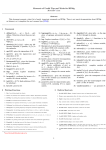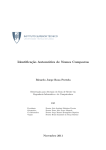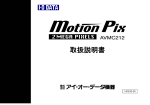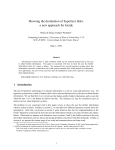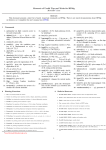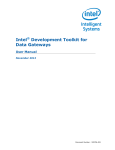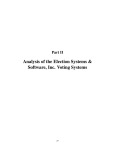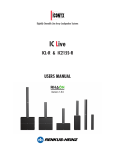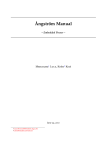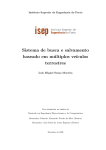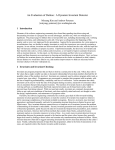Download An Embedded Module for Robotized Inspection of Power
Transcript
2nd International Conference on Applied Robotics for the Power Industry, ETH Zurich, Switzerland, September 11-13, 2012 Tu3A.2 An Embedded Module for Robotized Inspection of Power Lines by Using Thermographic and Visual Images Walter Fetter Lages Vinı́cius Scheeren Department of Electrical Engineering Federal University of Rio Grande do Sul Porto Alegre, RS, 90035-190 BRAZIL E-mail: [email protected] Department of Electrical Engineering Federal University of Rio Grande do Sul Porto Alegre, RS, 90035-190 BRAZIL E-mail: [email protected] Abstract—This paper deals with an embedded module for automation of thermographic inspection. The module captures video streams from an infrared camera and from a visible image camera and performs an image processing to detect faults. The protocols used to capture the image streams and the image processing are discussed. The results, with the faults highlighted, are sent through an synthetic image stream to a supervision station. I. I NTRODUCTION Power lines can wear out because of several factors, which can result in high power loss or even complete power faults caused by broken lines. Emergency repair procedures are high costly, motivating the development of systems capable of detecting damaged lines in a predictive manner. Power line inspection robots have been proposed to overcame the problems associated to human inspection, such as the tedious task and the resulting fatigue of operators. This paper proposes an embedded module for robotized inspection of power lines by using thermographic and visual images. That module receives images from a thermographic camera and from a visible image camera, process them to detect faults and send the images and diagnostics to a remote monitoring station. Robotic systems for power line inspections have been proposed with research focusing on the locomotion system [1], [2], as well as on methods for fault detection [3], [4]. As the proposed module will be embedded in a robot, dimensional, weight and power consumption requirements become very important. It is a paradox, but even with the robot operating in active lines, the power available to the robot is limited, since it should operate from batteries or power obtained by induction from the power line itself. However, the methods to obtain power from the line itself can provide only about a hundred Watts [5]. This paper is organized as follows: in section II, the hardware for thermographic and visual image capture and processing is described. Section III presents the processing of the thermographic images to detect hot-spots and abnormal conditions in the power line, while section IV shows the details of the capture of the video streams from the thermographic ©2012 IEEE camera. The software implementation of the system is described in section V and section VI presents some results and concluding remarks. II. H ARDWARE The thermographic camera is a FLIR A320, which send images through an Ethernet connection using RTSP (RealTime Streaming Protocol) [6]. Table I shows the stream formats supported. All formats are 16 bits per pixel. TABLE I S TREAMS SUPPORTED BY FLIR A320 CAMERA . Encoding MPEG4 MPEG4 MPEG4 FCAM FCAM RAW RAW Resolution 640 × 480 320 × 240 160 × 120 320 × 240 160 × 120 320 × 240 160 × 120 Note that the MPEG4 640 × 480 format is an interpolated resolution, as the sensor resolution is 320 × 240. The FCAM is a Flir proprietary format for raw data. Streams in RAW format can be either raw data from the camera sensor or a radiometric image, calibrated in Kelvin. The measurement range is from 0o C to 350o C with an accuracy of ±2o C. The temperature resolution can be set to be either 0.1 Kelvin or 0.01 Kelvin. In this work, a 320 × 240 RAW radiometric stream with resolution of 0.1 Kelvin was used. The frame rate is 9 Hz. The processing module is a BeagleBoard-xM, which uses an ARM processor due to its good ratio between processing power and power consumption, which also motivates its use in cell-phones, PDAs and tablets. Another important point is that the ARM processor is well supported by the Linux operating system, which can be easily customized for a low footprint in memory and system resources. The OpenEmbedded crosscompilation framework [7] is used to generate a customized version of the Linux Ångström distribution [8]. The visible spectrum camera is a Logitech C2010, which uses an USB connection. 58 After the processing of the thermographic and visual images, the embedded inspection module generates another RTSP stream with the results of the image processing, as shown in figure 1, where the detected faults and their locations are evidenced. That stream is received in a monitoring station. The Live555 library is used to receive and transmit RTSP streams. pixels belonging to the foreground and those belonging to the background: 2 σW = ωb (µb − µt )2 + ωf (µf − µt )2 (1) 2 Tt∗ = arg max σW (2) Tt where: 2 σW : variance; ωb : probability of a pixel belonging to the background; ωf : probability of a pixel belonging to the foreground; µb : mean of background pixel values; µf : mean of foreground pixel values; mean of all pixel values; µt : Given the thermographic image α(x, y), the foreground γ(x, y) is given by: ( α(x, y) if β(x, y) = 1 γ(x, y) = (3) 0 otherwise where the foreground mask β(x, y), is given by: ( 1 if α(x, y) ≥ Tt∗ β(x, y) = 0 otherwise (4) Then, the hot-spots are detected based on the hottest pixels of the foreground. First, the hottest pixels in foreground image are searched for, resulting in a seed image: ( 1 if α(x, y) = Tmax Ω0 (x, y) = (5) 0 otherwise with Tmax = max γ(x, y) (6) Tmin = min γ(x, y) (7) x,y x,y Fig. 1. System hardware. III. T HERMOGRAPHIC I MAGE P ROCESSING Each frame from the thermographic camera is processed to detect faults on the transmission line. The image processing is based on the Thermography Anomaly Detection Algorithm (ITADA) [9] to detect hot-spots and classify the fault. The ITADA algorithm is based on statistical and morphological methods. The first step is to segment the image in lower and high temperature areas, named the background and the foreground of the image, respectively. Only the foreground is further processed in search for hot-spots since it represents the power line. The background is discarded as it represents the surrounding environment and not the power line. The image segmentation is done by thresholding. The threshold value Tt∗ is determined dynamically for each frame by using the Otsu method [10], which maximizes the variance between the ©2012 IEEE The hot-spots are obtained by growing the seed image Ω0 (x, y) in recursive dilation operations with an 8neighborhood mask B: Ωk (x, y) = (Ωk−1 (x, y) ⊕ B) ∩ C(x, y) with the constraint C given by: ( 1 if Tmax − 0.6(Tmax − Tmin ) C(x, y) = 0 otherwise (8) (9) Hence, a neighbor pixel belongs to the hot-spot if its temperature is greater than Tmax −0.6(Tmax −Tmin ). Dilation operations are recursively performed until convergence to stable hot-spot regions such that Ωk (x, y) = Ωk−1 (x, y) = Ω∗ (x, y). Small hot-spots are regarded as a consequence of noise and are discarded. Therefore, the dilation operations makes the method more robust and less sensitive to noise, as the hot-spot detection requires local support of many pixels. Furthermore, the dilation avoids the segmentation of a hot-spot in two or 59 more due to noise. Each connected region in Ω∗ (x, y) is a hot-spot Ai (x, y), with i = 1 · · · Nh . The mean temperature of each hot-spot Thoti is used to detect faults in the cable and is given by: Thoti = 1 XX γ(x, y)∀(x, y) ∈ Ai (x, y) Di x y with Di = XX x Ai (x, y) (10) (11) y Each hot-spot temperature Thoti is compared to the mean temperature of the foreground without the detected hot-spots Tref , which represents the cable temperature under normal conditions. The reference temperature is computed based on the foreground without the hot-spots: ρ(x, y) = β(x, y) ∩ Ω∗ (x, y) IV. I MAGE R ECEPTION AND T RANSMISSION The stream from the thermographic camera is in the format defined by RFC4175 RTP Payload Format for Uncompressed Video [11]. The uncompressed format is ideal for image processing, as there are not distortions introduced by the compression and there is no time spent decompressing the image. After the image processing and fault detection, the inspection module transmits the results using the MPEG4 format, which is a compressed format, in order to reduce the required bandwidth and to enable the visualization in any standard media player such as VLC or Mplayer. The results from the inspection module are used just for visualization and not for processing. Hence, there is no need to transmit uncompressed video. However, in both cases, the stream is transmitted as a RTP (Real Time Protocol) [12] frame. Figure 2 shows the protocol stack. (12) where ¯· denotes the complement of ·. The reference temperature mask ρ(x, y) has a total number of pixels given by: XX ρ(x, y) (13) Nref = x y Then, the reference temperature can be computed as: Tref = 1 XX γ(x, y)if ρ(x, y) = 1 Nref x y (14) Hot-spots are classified according to table II based on the percent raise of its average temperature Thot1 with respect to the reference temperature Tref [9]: ∆T i = Thoti − Tref Tref (15) TABLE II H OT- SPOT CLASSIFICATION . Condition Normal Attention Fault ∆T i ∆T i < 9% 9% ≤ ∆T i < 90% 90% ≤ ∆T i The determination of the threshold value for image segmentation is the most demanding step in terms of computing resources, as the optimization is performed by exhaustive search. The variances should be computed by supposing that the threshold value is each point in histogram of 16 bit data. That means to compute the variances of the foreground and background 65536 times for each frame. In order to reduce the computing time, an auxiliary histogram is built by using only the most significant byte of each data. That way, a 256 time smaller histogram is obtained, which is used to compute an approximation of the optimal threshold value. This approximate value is used as a initial point for a local search for the optimal point in the full histogram. ©2012 IEEE Fig. 2. Protocol stack. The Real Time Streaming Protocol (RTSP) [6], is used to control the transmission of the streams through the commands: • OPTIONS: list the supported optional commands • DESCRIBE: list the streams available by the camera • SETUP: set one RTP session using a specific stream • GETPARAMETER: get parameters like frame rate and file format • PLAY: start to send the streams • PAUSE: pause the sending of streams • TEARDOWN: close the RTP session Hence, the user can control the stream transmission much like a DVD player. Figure 3 shows the state machine of the RTSP protocol. The Session Description Protocol (SDP) [13] is used to describe the desired session parameters such as such as session name, media name, address and connection information. The SDP protocol is used in the setup phase. In this phase, the server describes the available streams to the client, which then configures the parameters for the desired stream. Figure 4 shows the SDP description for the RAW 320 × 240 stream used in this work. The SDP session description begins at the line which starts with v=0. 60 Fig. 3. RTSP state machine. Notice the line starting with a=rtpmap: which starts the description of the desired stream. The stream is described by a=rtpmap:103 raw/90000, a=framesize:103 320-240 and a=fmtp:103 sampling=mono; width=320; height=240; depth=16. RTSP/1.0 200 OK CSeq: 2 Date: 24 May 2012 12:58:17 GMT Content-Type: application/sdp Content-Length: 402 Content-Base: rtsp://10.1.32.1/ v=0 o=- 0 0 IN IP4 10.1.32.1 s=IR stream i=Live infrared t=nowc=IN IP4 10.1.32.1 m=video 13124 RTP/AVP 103 a=control:rtsp://10.1.32.1/sid=103 a=framerate:30 a=rtpmap:103 raw/90000 a=framesize:103 320-240 a=fmtp:103 sampling=mono; width=320; height=240; depth=16 Fig. 4. SDP description for the RAW 320 × 240 stream. Fig. 5. Data flow. V. S OFTWARE I MPLEMENTATION The software executing in the inspection module is divided in three modules running as daemons, as shown in figure 5: • receiver: receives images from the thermographic camera. • detector: captures images from the visual camera, acquires the images from the receiver and detects hostspots and faults, generating a synthetic images with the hot-spots and fault data. • transmitter: Transmits the stream of synthetic images generated by the detector. There is not a specific daemon for the capture of visual camera images because the camera supports the UVC format, which has an available driver in the Linux kernel. However, the camera image is represented in the YUV model. The image is converted to the RGB model by (16)-(18). R = 1.164(Y − 16) + 1.596(V − 128) G = 1.164(Y − 16) − 0.813(V − 128) B = ©2012 IEEE (16) −0.391(U − 128) (17) 1.164(Y − 16) + 2.018(U − 128) (18) The modular system architecture allows for an easy replacement of the receiver or transmitter modules, should another stream format be more convenient. The communication and data transfer between the modules is done by shared memory, thus avoiding to copy images. The read and write operations are synchronized by semaphores. The liveMedia library from the live555 project [14] is used to decode the RTP (Real-Time Protocol) [12] received stream and to encode the RTP stream to be transmitted. The architecture of this library defines the abstract FramedFileSource and MediaSink classes, representing a generic source or sink of streams. However, in the implementation of the live55 library, those classes are derived to implement only the ByteStreamFileSource and FileSink classes. Those classes implement stream read and write operations from (magnetic media) files. Due to the low performance, limited by the file system, that is not a good solution for sharing streams between tightly coupled tasks as the implemented by the inspection module daemons. In order to use shared memory based communication, the abstract classes of the liveMedia library were derived in 61 two new classes, ShmSink, to receive a stream through shared memory and ByteStreamShmSource to send the stream through shared memory. The ShmSink class is used by the receiver daemon to receive streams from the thermographic camera through shared memory, while the ByteStreamShmSource class is used to to send the stream to the transmitter daemon through shared memory. Note that those new classes are extensions of the classes from the liveMedia library which as not changed in any way, ensuring the compatibility and correctness of the stream handling. The receiver daemon receives a stream from the thermographic camera an sends the data to the detector daemon. An RTSP session with the camera is initiated, then, the appropriate stream (RAW data without compression) is selected. The received RTP frames are sent to the detector daemon. The frames are sent with the headers defined by RFC4175 and there is no direct correspondence between each RTP frame and each image frame. The detector daemon should concatenate the RTP frames to assembly an image frame to be processed. The detector daemon, processes the image and generates a stream with the results, which is transmitted by the remote monitoring station by the transmitter daemon. A requirement for the development of the inspection module was that the monitoring station should be required to execute any proprietary software, in order to enable any computer to be used as a monitoring station. Therefore, the stream with results is transmitted in MPEG4 format, which can be visualized by using any conventional player such as VLC or Mplayer. The conversion of the video stream to the MPEG4 format is done by using the libavcodec library [15]. Even if the processed stream is transmitted to the remote monitoring station, for debugging purposes it is convenient to view the images while they are still in the processing module. Hence the detector has a optional graphical interface based on the GTK library [16], which can be used to see the generated stream before transmission to the monitoring station. Figure 6 shows such an interface. The upper left corner of the figure shows the thermographic image, while the lower left images shows the detected foreground. The upper right image shows the detected hot-spot and the lower right image shows an image in the visible spectrum. The text in the bottom of the window shows the classification of the hot-spot. Fig. 6. Detector graphical interface. Fig. 7. Results seen in the VLC player. VI. C ONCLUSION Experimental results are shown in figure 7, where a the screen of the monitoring computer running the VLC player can be seen. A damage in the cable was mechanically forced, thus reducing its section. A high current power source was used to simulate the high currents seen in real power lines. The system was able to efficiently detect faults, producing a real time report for the operator where the detected faults are highlighted. The requirements of low power consumption and small dimensions were satisfied, as well. ACKNOWLEDGMENT The authors would like to thank the financial support from Conselho Nacional de Desenvolvimento Cientı́fico e ©2012 IEEE 62 Tecnológico (CNPq), Coordenação de Aperfeiçoamento de Pessoal de Nı́vel Superior (CAPES), Fundação de Apoio à Pesquisa do Estado do Rio Grande do Sul (FAPERGS) and Companhia Estadual de Energia Elétrica (CEEE). R EFERENCES [1] S. Montamblaut, “About the future of power line robotics,” in Proceedings of the 1st International Conference on Appied Robotics for the Power Industry, Montréal, 2010. [2] V. M. de Oliveira and W. F. Lages, “Control of a brachiation robot for inspection of aerial power lines,” in Proceedings of the 1st International Conference on Appied Robotics for the Power Industry, Montréal, 2010. [3] H. Li and B. Wang, “Research on the infrared and visible powerequipment image fusion for inspection robots,” in Proceedings of the 1st International Conference on Appied Robotics for the Power Industry, Montréal, 2010. [4] J. H. E. de Oliveira and W. F. Lages, “Robotized inspection of power lines with infrared vision,” in Proceedings of the 1st International Conference on Appied Robotics for the Power Industry, Montréal, 2010. [5] J. Caxias, F. A. Silva, and J. F. C. S. Sequeira, “Transmission line inspection robots: Design of the power supply system,” in Proceedings of the 1st International Conference on Appied Robotics for the Power Industry, Montréal, 2010. [6] H. Schulzrinne, A. Rao, and R. Lanphier, “Real time streaming protocol (RTSP),” Network Working Group, RFC 2326, April 1998, available at hftp://ftp.ietf.org/rfc/rfc2326.txti. ©2012 IEEE [7] OpenEmbedded Team, OpenEmbedded User Manual, 2009, hhttp://docs/ openembeded.org/usermanual/usermanual.pdfi. [8] L. Merciadri and K. Koën, Ångström Manual, Jun 2010, hhttp://www.student.montefiore.ulg.ac.be/∼merciadri/angstrom/files/ angstrom-manual.pdfi. [9] Y.-C. Chou and L. Yao, “Automatic diagnosis system of electrical equipment using infrared thermography,” in Proceedings of the 2009 International Conference on Soft Computing and Pattern Recognition. IEEE Computer Society, 2009, pp. 155–160. [10] N. Otsu, “A threshold selection method from gray-level histograms,” Systems, Man and Cybernetics, IEEE Transactions on, vol. 9, no. 1, pp. 62–66, jan. 1979. [11] L. Gharai and C. Perkins, “RTP payload format for uncompressed video,” Network Working Group, RFC 4175, September 2005, available at hftp://ftp.ietf.org/rfc/rfc4175.txti. [12] H. Schulzrinne, S. Casner, R. Frederick, and V. Jacobson, “RTP: A transport protocol for real-time applications,” Network Working Group, RFC 1889, January 1996, available at hftp://ftp.ietf.org/rfc/rfc1889.txti. [13] M. Handley, V. Jacobson, and C. Perkins, “SDP: Session description protocol,” Network Working Group, RFC 4566, July 2006, available at hftp://ftp.ietf.org/rfc/rfc4566.txti. [14] LIVE555 Streaming Media, Live Networks, Inc., Mointain View, CA, 2011, available at hhttp://www.live555.com/LiveMediai. [15] Libav, Libav codec library, 2012, hhttp://www.libav.orgi. [16] The GTK+ Team, “The GTK+ project,” 2012, hhttp://www.gtk.orgi. 63







